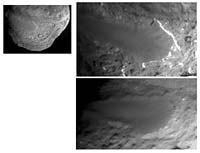|
COMETS EARTH JUPITER KUIPER BELT MARS MERCURY METEORITES NEPTUNE OORT CLOUD PLUTO SATURN SOLAR SYSTEM SPACE SUN URANUS VENUS ORDER PRINTS
PHOTO CATEGORIES SCIENCEVIEWS AMERICAN INDIAN AMPHIBIANS BIRDS BUGS FINE ART FOSSILS THE ISLANDS HISTORICAL PHOTOS MAMMALS OTHER PARKS PLANTS RELIGIOUS REPTILES SCIENCEVIEWS PRINTS
|
Related Documents
Download Options
This image layout depicts changes in the surface of comet Tempel 1, observed first by NASA's Deep Impact Mission in 2005 (top right) and again by NASA's Stardust-NExT mission on Feb. 14, 2011 (bottom right). Between the two visits, the comet made one trip around the sun. The image at top left is a wider shot from Deep Impact. The smooth terrain is at a higher elevation than the more textured surface around it. Scientists think that cliffs, located near the prominent white lines, are being eroded back to the left in this view. The cliffs appear to have eroded as much as 20 to 30 meters (66 to 100 feet) in some places, since Deep Impact took the initial image. The middle left of the images show depressions that have merged together over time, also from erosion. This erosion is caused by volatile substances evaporating away from the comet. Stardust-NExT is a low-cost mission that will expand the investigation of comet Tempel 1 initiated by NASA's Deep Impact spacecraft. JPL, a division of the California Institute of Technology in Pasadena, manages Stardust-NExT for the NASA Science Mission Directorate, Washington, D.C. Joe Veverka of Cornell University, Ithaca, N.Y., is the mission's principal investigator. Lockheed Martin Space Systems, Denver, built the spacecraft and manages day-to-day mission operations. |
